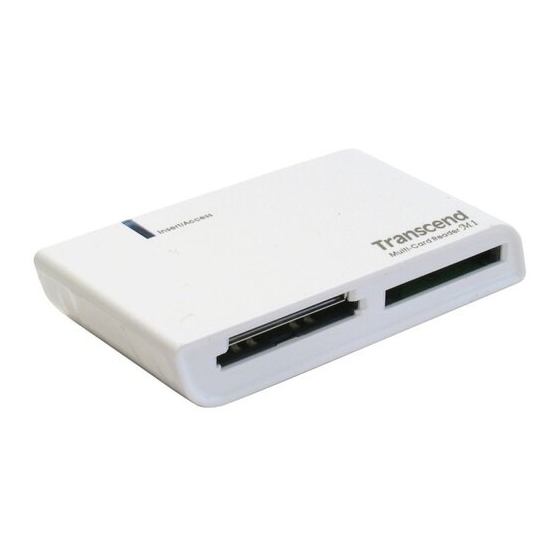
Table of Contents
Advertisement
Advertisement
Table of Contents

Summary of Contents for Transcend Portable Multi-Card Reader
- Page 1 Transcend Multi-Card Reader User’s Manual...
-
Page 2: Table Of Contents
Driver Installation for Linux™ Kernel 2.4, or Later ................5 Connecting to a Computer ....................6 Disconnecting from a Computer ...................7 ® Removing the Multi-Card Reader in Windows 98/98SE ..............7 ® Removing the Multi-Card Reader in Windows Me, 2000 and XP ............7 ™... -
Page 3: Introduction
Memory Cards and without the need for an adapter. Transcend’s Multi-Card Reader plugs into the USB port on your Desktop, or Notebook computer and accepts the direct input of the most popular Memory Cards (see “Specifications” for details) . In addition, Transcend’s Multi-Card Reader also accepts the input of a large number of reduced sized... -
Page 4: Safety
General Use Carefully unpack the contents of the Multi-Card Reader package. Do not allow your Multi-Card Reader to become damp or wet from water or any other liquids. Do not use a damp/wet cloth to wipe or clean the exterior case. -
Page 5: Use With A Computer
Driver Installation ® Driver Installation for Windows 98/98SE, 2000 (SP1 and SP2) Put the Driver CD into the CD-ROM (Auto-Run supported). Click on the “Driver Installation” button. Figure 1. Windows 98/98SE/2000 (SP1 & SP2) Driver Installation The InstallShield Wizard will guide you through the installation process. Follow the on-screen instructions to complete the driver installation. -
Page 6: Driver Installation For Windows ® Me, 2000 (Sp3, Or Later) And Xp
After the drivers are installed onto the computer, plug the Multi-Card Reader into an available USB port, the “New Hardware Found” dialogue boxes will appear. Figure 3. Found New Hardware The computer will automatically detect the Multi-Card Reader and a number of Removable Disk* drives with newly assigned drive letters representing the readers’... -
Page 7: Driver Installation For Mac ™ Os 9.X
Driver CD. Follow the on-screen instructions to complete the driver installation. Plug the Multi-Card Reader into an available USB port. Insert a memory card into the Multi-Card Reader. A disk icon will appear on the desktop. After the icon ™... -
Page 8: Connecting To A Computer
USB A-Type (on a Desktop/Notebook) cable. Please ensure that you connect the cable ends to the ports correctly. If your Multi-Card Reader came with a Mini USB to USB A-Type cable, use it to plug the Multi-Card Reader into an available USB port on your desktop, or notebook computer. -
Page 9: Disconnecting From A Computer
™ Removing the Multi-Card Reader in Mac OS 9.x, or Later Drag and drop the Disk icon corresponding to your Multi-Card Reader into the trashcan. Then unplug your Multi-Card Reader from the USB port. ™ Remove the Multi-Card Reader in Linux Kernel 2.4, or Later... -
Page 10: Driver Installation For Mac ™ Os 10.1.2, Or Later
Check the following: Is your Multi-Card Reader properly connected to the USB port? If not, unplug it and plug it in again. Is your Multi-Card Reader connected to the Mac keyboard? If yes, unplug it and plug it into an available USB port on your Mac Desktop. -
Page 11: Specifications
Multi-Card Reader M1 Specifications • Size (L x W x H): 64 mm × 33 mm × 12 mm • Weight: • Max. Transfer Speed: 480Mbits (60MB) per second • Operating Voltage: 5V DC from USB Port • Operating Temperature: 0℃... -
Page 12: Portable Multi-Card Reader Specifications
™ ™ Secure Digital (SD microSD /TransFlash ™ ™ ™ MultiMediaCard (MMC RS-MMC, MMCmobile , MMCmicro Ordering Information Device Description Transcend P/N Transcend Portable Multi-Card Reader Blue TS-RD13B Transcend Portable Multi-Card Reader Orange TS-RD13R Transcend Portable Multi-Card Reader Silver TS-RD13S... -
Page 13: Compact Card Reader Specifications
Secure Digital (SD miniSD , microSD /TransFlash ™ ™ ™ MultiMediaCard (MMC RS-MMC, MMCmobile , MMCmicro ® Memory Stick Duo , Memory Stick PRO ® Memory Stick (MS): ® Ordering Information Device Description Transcend P/N Transcend Compact Card Reader TS-RDC... -
Page 14: Compact Card Reader S1 Specifications
), miniSD ™ ™ , MMCplus , RS-MMC, ™ MultiMediaCard (MMC ™ MMCmobile Memory Cards w/Adapter ™ ™ ™ Secure Digital (SD microSD /TransFlash ™ ™ MultiMediaCard (MMC MMCmicro Ordering Information Device Description Transcend P/N Transcend Compact Card Reader S1 TS-RDS1... -
Page 15: Warranty
Transcend is not responsible for recovering any data lost due to the failure of a hard drive or flash memory device. Transcend’s Multi-Card Reader must be used with devices that conform to the recommended industry standards. -
Page 16: Terminology
Terminology adapter.................................3 Device that is used to connect one hardware device to another without a loss in function. CD-ROM .............................5, 7, 10 Compact Disk-Read Only Memory is a compact disk format that can store music, text and graphics. Desktop..............................10 ® ™...















Need help?
Do you have a question about the Portable Multi-Card Reader and is the answer not in the manual?
Questions and answers